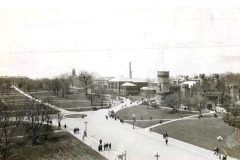Oval
Originally, there was no formal plan for an Oval. The space in front of University Hall was intended to be a large rectangle, in the tradition of an English manor.
By 1900, however, the Oval began to form as buildings cropped up around the open space. In 1905 there were no sidewalks and students joked of people disappearing into the mud. The mud paths were studied and eventually their locations influenced where sidewalks were placed.
The Oval also contains several memorials. The most well-known is perhaps “The Five Brothers,” which is composed of five elm trees planted as a class gift. The originals were planted in 1891 and succumbed to Dutch Elm Disease, the last in 1971; the replacements were planted in 1987. Other memorials include the flagpole in front of Bricker Hall, dedicated in 1917 to graduates killed in WWI, and a sundial, a gift from the class of 1905, which now stands in Sphinx Plaza.
The Oval has been home to commencements, rallies, student demonstrations, cavalry drills, contests, and even a musical chairs contest for charity.







